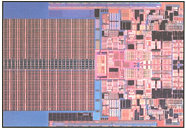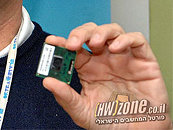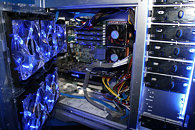News Posts matching #intel
Return to Keyword Browsing
As you probably know, Intel is working on their own graphics card. Most people scoff at this idea, considering that Intel was rumored to buy NVIDIA so that they could have graphics cards. However, in a few years (late 2008/2009), Intel is planning on becoming a serious threat to the market dominance owned by NVIDIA and ATI. Intel is claiming that by late 2008 they will have at least sampled a card with multiple cores (up to sixteen) on one die. They also claim they will be able to do this on a 32nm architecture. This 16 core, 32nm GPU is estimated to run sixteen times faster than the 8800GTX.
For the first time in 66 years, there are an equal number of female and male finalists.
Forty high school seniors today were named finalists for the Intel Science Talent Search (Intel STS) 2007. The competition is America's oldest and most prestigious high school science competition; six former finalists have won the Nobel Prize and others have been awarded the Fields Medal, the National Medal of Science and MacArthur Foundation fellowships.
Intel expects to introduce its high-end Core 2 Extreme branding to notebooks in Q3'2007 according to the latest roadmap. The upcoming Core 2 Extreme X7800 uses the same Merom core used by the Core 2 Duo mobile family of processors. Intel's Core 2 Extreme X7800 will arrive clocked at 2.6GHz with 800MHz FSB and 4MB of L2 cache like the rest of the Core 2 Duo family. Intel technologies such as VT, EIST, EM64T and XD/NX bit are also supported, though Intel has removed support for Intel Dynamic Acceleration. The Core 2 Extreme X7800 for mobile will remain at the top of Intel's chain of mobile processors until the upcoming Core 2 Extreme X7900(2.8GHz 4MB L2) dethrones it in Q4'2007. The price of Core 2 Duo Extreme X7800 for notebooks in Q3'2007 is expected to be $795 per-unit in 1,000-unit quantities.
The Intel Core 2 Duo series is about to embark on a die shrink, from 65nm to 45nm. The new Core 2 Duo's, codenamed "Penryn", will have a slew of new features. The Penryn's will support a new set of SSE instructions, have higher clock speeds while maintaining the same power draw, and have a larger L2 Cache. The dual core Penryn will have 410 million transistors, and the quad core Penryn will have 820 million. All of the Penryn's will be on a 300mm package. Like with the current generation quad core offerings, the quad core Penryn's will have two dual core processors on one package. The Penryn series will have the same power requirements as the Conroe, which translates to 35W laptop chips, 65W dual-core desktop chips, and 80W quad-core desktop chips. Intel has successfully tested the Penryn's on several operating systems for stability, and we should see something commercially available around Q2 2007.
Penryn, the 45nm successor to Conroe on the Intel roadmap, will have several new features the previous lacked. One of these is Intel HyperThreading, which would give a computer four logical cores on a dual-core processor. Intel's Penryn may also have up to 6MB of L2 Cache, and other than the die shrink, will have a lot of minor performance tweaks.
Intel Corporation today introduced the Intel Next-Gen Wireless-N network connection, an upgrade to the wireless component found inside Intel Centrino Duo mobile technology and other Intel-based laptops that helps consumers better connect to wireless networks. As notebook PCs increasingly download broadband-intense content such as movies, videos and music, a more powerful networking solution is needed. Based on the draft 802.11n Wi-Fi specification, the Intel Next-Gen Wireless-N technology addresses that need by offering users up to five times the performance and twice the wireless range - while providing up to an extra hour of notebook battery life when compared to existing Draft-N products.
Intel has confirmed that they formed the "Visual computing group" which shall be the future of computing for "high-throughput workloads". Intel is already looking to hire graphic engineers for this purpose. Together this might suggest Intel is indeed going to create chips for add on cards once again.
Even though the high end market is quite small compared to on board graphic processors it still has a value of $5 billion a quarter, which is a lot, even for a giant like Intel. Having their own high end GPU would also give them a chance to strengthen their grip on the console market.
Intel did not comment on these speculations.
Sun Microsystems, Inc. and Intel Corporation today announced a broad strategic alliance centered on Intel's endorsement of the Solaris Operating System (OS) and Sun's commitment to deliver a comprehensive family of enterprise and telecommunications servers and workstations based on Intel Xeon processors. The new Intel-based enterprise systems from Sun will enhance its current X64 portfolio and complement its industry-leading, powerhouse SPARC systems.
Intel has released its newest addition to the Core 2 Duo family with the new low-end E4300. Running at 1.8GHz, this CPU has a frontside bus speed of 800MHz and a 2MB L2 cache, the first processor in the range without a 1,066MHz FSB. Although Intel hasn't provided any details yet itself, news of this processor was first released in November 2006 when it was leaked on the company roadmaps. Two more low-end Core 2 Duos are expected next quarter, the 1.6GHz E4200 and the 2GHz E4400, both with an 800MHz FSB. These new CPUs are aimed at lower performing systems with a tighter budget in mind - the E4300 should cost around $163.
Intel Corporation today announced fourth-quarter revenue of $9.7 billion, operating income of $1.5 billion, net income of $1.5 billion and earnings per share (EPS) of 26 cents. Excluding the effects of share-based compensation, the company posted operating income of $1.8 billion, net income of $1.7 billion and EPS of 30 cents.
For more details of Intel's Q4 2006 earnings, please read the full release PDF
here.With AMD announcing disappointing figures for 2006 regarding its share of the CPU market, silicon rival Intel also suffered at the end of 2006 with profits falling by 39% compared to 2005. During Q4 2005 the company made $2.24bn, but during the same period of 2006 it made only $1.5bn, with overall revenue for the last quarter down 5%. This still beat analyst expectations however, achieving a turnover of $9.7 instead of the predicted $9.44, with the fall mostly accredited to increased competition from AMD forcing prices down. The firm is now hoping for its revenue to be between $8.7bn and $9.3bn for Q1 2007.
With AMD's Quad FX processors recently launched with the ability to run a pair of dual-core CPUs, Intel has unveiled its next step to strengthen its hold on the market. At CES 2007, the silicon giant announced a proof-of-concept PC designed to counter AMD's 4x4 systems, named the V8. The system contains a pair of quad-core processors running at 2.4GHz using a 1066MHz system bus - when paired with an NVIDIA 8800GTX it manages to score 6089 on the 3Dmark06 CPU benchmark. However, it isn't all good news for Intel fans. The V8 system requires FB-DIMMs and only works with a single GPU at present, whilst Quad FX systems can use standard unbuffered memory along with multiple GPUs. If Intel doesn't manage to solve the problem with multi GPU support soon this may give AMD time to release 8x8 systems, which wouldn't be part of Intel's plan.
Further testing by Intel and Microsoft has found that integrated graphics can run the Vista Aero interface just fine. It may not be the best choice for laptop users (the same ones using these integrated graphics chipsets, as it drains laptop batteries very quickly. However, Aero Glass sure does look pretty, which matters to some people more than battery life.
Intel started shipping the three new quad-core processors, we told you about
here. One new mainstream Core 2 Quad Q6600 and two single processor workstation and server Xeon X3220 and X3210 processors are now available. Official pricing for the Q6600 per unit in 1,000 unit quantities is $851 with a price drop to $530 expected in Q2'2007. Online retailer
ZipZoomFly currently has the Core 2 Quad Q6600 in stock for $989.99. Pricing for the Xeon X3220 is identical to the Core 2 Quad Q6600 at $851 per unit in 1,000 unit quantities with an expected price drop to $530 in Q2'2007. The lower clocked Xeon X3210 is priced at $690 per unit per 1,000 unit quantities with an expected price drop to $425 in Q2'2007.
Intel plans to launch three quad-core processors on Monday, covering two Xeons for lower-end servers and one mainstream model, the Core 2 Quad 6600 for desktop computers. The new Core 2 Quad 6600 processor will run at 2.4GHz with 1066MHz FSB. Also set to arrive are two low-end Xeons, the 2.13GHz 3210 and 2.4GHz 3220. Both are designed for single-processor servers. The chips have 8MB cache and a 1066MHz front-side bus. Intel declined to comment the story, but the three CPUs are expected to show up at the Consumer Electronics Show in Las Vegas next week.
Intel Corporation and CinemaNow, a leading Internet provider of downloadable videos, today announced a collaboration that will allow consumers using Intel technology-based media PCs, such as those with Intel Viiv technology, to legally download and record major motion picture movie content to blank DVD discs for playback on both the PC and consumer electronics devices, including most standard DVD players.
In a small city near the Nile River where cars compete with cattle and modern conveniences are scarce, Intel Corporation is using computers and wireless technology to help Oseem's 200,000 residents tap into vast "knowledge resources" on the Internet in hopes of bettering their lives.
"Technology has expanded what is possible for the people of Oseem," said Intel Chairman Craig Barrett. "Intel is committed to support Egypt's leaders in accelerating access to technology so its people can get better health care, education and work skills."
AMD today announced a significant legal victory in its ongoing antitrust suit against Intel Corporation. In an order effective yesterday, the Federal District Court in Delaware overruled Intel's objections and ordered it to produce documents and other evidence bearing upon Intel's exclusionary conduct outside of U.S. borders.
Quarter 3 of 2007 will be very interesting for the hardware industry, as Intel plans to roll out the first motherboard with DX10 compatible integrated graphics. The G35 will support Intel Clear Video Micro-architecture, DDR2 and DDR3 memory simultaneously, and possibly an FSB of 1333 MHz. It can and will be matched with ICH9, ICH9R, ICH9DH Southbridges
Intel plans to announce its Core 2 Solo single-core processors in Q3 2007. Instead of normal edition, the upcoming Core 2 Solo has ULV (Ultra Low-Voltage) edition only. The new Core 2 Solo ULV includes two models: U2200 (1.2 GHz/1MB L2/533MHz) and U2100 (1.06 GHz/1MB L2/533MHz). They are set to replace the U1500 and U1400 processors. These two models have only 5W power consumption and support for Intel VT, EIST, XD Bit and Intel EM64T. All Core 2 Solo ULV CPUs will be released in Socket M interface instead of Socket P for Santa Rosa.
Intel is initiating a B-2 to L-2 stepping conversion for Intel Core 2 Duo processors E6300 & E6400 (Conroe) and Dual-Core Intel Xeon processors 3040 & 3050 (UP Xeon processors based on Conroe) where they will undergo the following changes:
- New S-Spec and MM numbers for the converting products
- CPUID will change from 6F6 to 6F2
- Extended HALT power specification will reduce from 22 Watts to 12 Watts
- Die size optimized for manufacturability
- Minor visible difference between the B-2 and L-2 packages; see below for a visual comparison
- L-2 package is pin compatible with B-2 package
Intel has quietly begun shipping its latest Clovertown Xeon quad-core processor-the Xeon E5335. The latest Xeon E5335 arrives at 2.0GHz which slots it between the E5345(2.33GHz) and the E5320(1.86GHz). While the Xeon E5320 and lower models operate on 1066MHz front-side buses, the new E5335 features a 1333MHz FSB. As with the other models in the Xeon lineup the E5335 features 8MB of L2 cache. Expect Xeon E5335 processors to arrive soon with a price of $690 per processor in 1000 unit quantities.
Intel has announced the end of the Celeron D 326, 346, 351 and 355 processors. Orders for the products become unchangeable on 2 February 2007, and no further orders will be accepted after 6 April 2007, Intel documents reveal. Intel is clearing all its Pentium and Celeron CPUs to make way for the increasing mainstream-oriented Core 2 Duo family and for future Core-based Pentium processors.
Intel Corporation today announced design completion of its first mobile WiMAX baseband chip. Combined with the company's previously announced single-chip, multi-band WiMAX/Wi-Fi radio, the pair creates a complete chipset called the Intel WiMAX Connection 2300. This development marks another major step in Intel's efforts to deliver an "always best connected" mobile Internet experience for future laptops and mobile devices.




